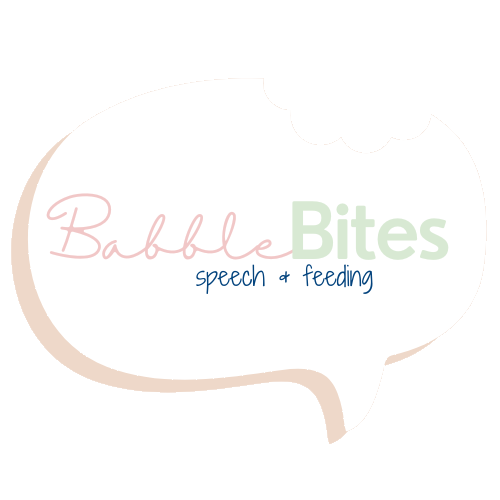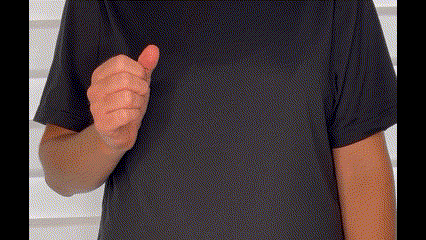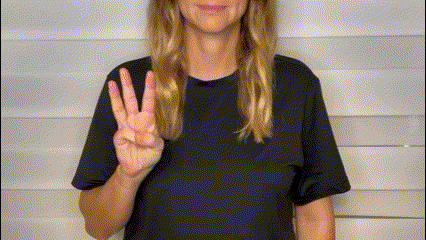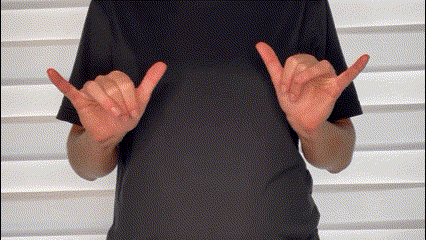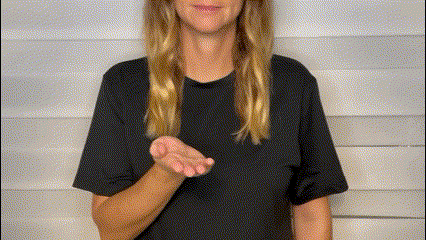Unlocking Early Communication: A Guide to Teaching Sign Language to Your Baby
Figuring out your baby’s wants and needs before they are able to talk can be frustrating for you and your child. Teaching your baby sign language can bridge the communication gap while your baby’s verbal language is still developing, and empower both you and your baby.
The sign for “more” is a versatile first sign to teach.
Will teaching my baby sign language delay their speech and language development?
Many parents wonder if teaching their baby sign language will delay their verbal language, and based on research, the answer is no! In general, babies have the capability to learn signs even earlier than they are able to learn how to say words, so by exposing your infant to sign language, you are giving them the opportunity to communicate specific wants and needs with you even earlier, reducing both your frustration and your child’s.
For most children, once they learn to express themselves verbally, they will prefer this method, and the verbal word will replace the use of the sign. For example, verbally saying “more” rather than having to put down something they’re holding in order to make the sign will be easier for your child, so no worries that they will not use verbal words if they are taught signs.
At what age can I teach my baby sign language?
Most babies can start to imitate and use signs independently as early as 6-9 months, while verbal words do not start to develop until around12 months. You can begin modeling signs even earlier than 6 months, but babies won’t have the skills to start using them until 6 months or later. It’s never too early or too late to start incorporating them into your daily routines.
Does sign language help children with a speech and language delay?
Teaching sign language to children whose language is delayed is also extremely beneficial for the same reasons. Children will often pick up on using signs before they will start to use verbal words, thus giving them a way to communicate with you. Children with language delays and disorders may continue to use signs for longer than children without delays, but it is not the use of the signs that is causing the delay. In fact, using sign language with children with delayed speech and language gives them a gateway to communicating with those around them, and adds to their expressive vocabulary.
Teaching sign language gives children access to communication.
What are the benefits of teaching my baby sign language?
Teaching your baby sign language comes with many benefits including earlier development of expressive vocabulary (signs count as first words!), reduced frustration, earlier ability to communicate wants and needs, and smoother transitions. Learning signs also has a positive impact on cognitive development, as it helps strengthen memory, recognition, and association skills, as well as improves their ability to process visual information and develop their problem-solving skills.
Is “baby sign language” the same as American Sign Language (ASL)?
For the most part, the signs we teach babies come from American Sign Language (ASL). ASL is a complete language system with grammatical rules, while when teaching your baby sign language, you will primarily focus on single signs. If you do model phrases, you will likely utilize the word order of spoken English, as word order can vary in ASL. Additionally, some signs may be modified for your baby’s motor skills. You can choose to expose your infant to many signs, or just a few core signs. It is best to focus on vocabulary that is functional, and will help your baby communicate specific wants and needs to reduce frustration.
How do I teach sign language to my baby?
You can teach sign language to your baby the same way that you teach verbal language to your baby, by modeling it! The key to your baby learning to use signs is consistency with frequent exposures in context. Make sure to let others in your baby’s life know that you are working on teaching signs so they can model them, as well. Let them know if your baby starts to use signs to communicate in order to make sure other caregivers will know how to respond to your baby’s new communication skills. Plan to tell daycare providers, babysitters, nannies, grandparents, and anyone else who is watching your child.
Step 1:
Model the signs in context while saying the verbal word that pairs with the sign. For example, when teaching the sign for “more,” every time you give your baby more of a food, drink, or toy, or doing something again such as signing a song, or pushing a swing, model the sign while saying, “more.” You can also say the verbal word (and sign if you know it!) for whatever you are giving them more of (e.g. “more banana,” “more ball,” “more singing”). You can create opportunities for this by only giving your baby a little at a time (e.g. a few pieces of a preferred food, one ball to roll down a ramp, stopping the swing very few pushes, etc.), so that you have more opportunities to model “more,” and eventually, more opportunities for your baby to practice requesting “more” (this same strategy applies for verbal words down the line!).
Step 2:
Once you’ve modeled it frequently, encourage your baby to imitate the sign in context. For example, if you can see your baby wants more of something, before giving them more, model the sign and say, “more,” and encourage your baby to imitate you. If they don’t imitate yet, see if they let you help them with hand-over-hand (i.e. taking their hands and helping them do the sign). Some babies don’t like this, so don’t force it.
Step 3:
When they do imitate it, reinforce it by saying something like, “You told me more!” and giving them more of whatever it is they were requesting.
Step 4:
Once they start to imitate it, the next step would be to wait and see if they use it on their own. Instead of anticipating their needs by giving them more, wait. You can give them a verbal cue by saying, “more?” and see if that helps them remember to use their newly learned sign.
This same method can be applied to all of the early signs below! Some children may benefit from focusing on one to two signs at a time until they learn those, and then starting to teach more, but continuing to model the signs in context is what will really help your baby learn.
What signs should I teach my baby?
Here are the top signs I recommend introducing to your baby that can enhance early communication:
“More”
This is an extremely versatile sign that can be used with food, drinks, toys, singing, reading books, playing on the playground… anything your child may want to request more of!
“All done”
This can be used at the end of meals, when they’re done playing with a toy, or when they are trying to communicate that they don’t like something. This is a great one to help reduce throwing food off of the tray to communicate that they’re done eating!
“Open”
Use the sign for “open” with things like bags, doors, boxes, and books. By keeping toys in clear bins that your child needs help opening, it creates an opportunity for them to communicate!
“Help”’
Teaching the sign for help can be especially helpful to reduce moments of frustration. It can be modeled and used any time they need help with something! The American Sign Language sign can be a bit difficult for the motor skills of babies, so this one may have to be modified. You can modify by using a fist instead of a thumbs up. I also often teach a completely different sign to babies (tapping the chest with both hands), and as long as caregivers in the child’s life know what they are communicating, it will serve the same purpose, so don’t hesitate to modify signs as needed for your child. What’s important is that they are using a symbol to communicate a specific need — this is what language is all about!
“Eat”
This sign can be helpful to know when baby is hungry. Model it right before mealtimes, and while baby is eating. You can also model it while feeding toys like a baby doll or stuffed animal. If you are following a feeding schedule and the Division of Responsibilities, know that you as the parent still determine when meals and snacks are. It is nonetheless helpful to know if your child is hungry!
“Milk”
Teach this sign so your baby can request the breast or bottle. Of course it will depend if you are feeding on demand or following a schedule to determine how you will respond.
“Water”
Teach this sign so your baby can request a drink of water. You can also incorporate it into washing hands and bath time.
“Play”
Model the sign for “play” right before and while you are playing with toys, so baby can request play time.
“Up”
Use the sign for “up” before picking up your baby, and when going upstairs, so your baby can request to go up. Your baby also may use the gesture of lifting their arms up to be picked up, which is a great early communication skill, as well!
“Down”
Use this sign when your baby wants to get down, such as down from their high chair, out of their crib, or to be put down when being carried.
“My turn”
This sign can be used when your baby wants something that you are holding, and can also be used with early turn taking with toys (e.g. passing a ball back and forth, putting cars/balls down a ramp, taking a sip of water, etc.). Don’t forget to teach siblings baby’s new signs so they can communicate with their baby sibling, too! Modify this sign to an open hand rather than isolating the thumb and pointer finger as needed for your child.
Bonus signs:
While I like to focus on functional words before worrying about manners, these two signs are pretty easy for baby to pick up!
“Please”
You can incorporate the sign for “please” when your baby is requesting something. You can model two signs together, such as “more please” or “help please,” or use the sign for “please” on its own to make a request.
“Thank you”
You can teach this sign to your baby to use after giving something to them.
What if I am concerned with my child’s speech and language development?
If you are concerned about your child’s speech and/or language development, reach out to your pediatrician for a referral to a speech-language pathologist. If you are concerned about your child’s speech and language development, it’s important to get an evaluation with a speech-language pathologist. Early intervention has been proven to have better outcomes than the outdated “wait and see” approach. Every state has a state-funded early intervention program, although these programs can be difficult to qualify for. If you are still concerned, you can reach out to a private practice or outpatient facility in your area.
Check out my post here to learn about other skills that come before verbal language and how to encourage their development!
Follow us on Instagram for “bite-sized” information on language strategies:
Click below to pin this post to Pinterest to save for later and share!
This website and information on this blog post is provided for educational purposes only. It is not meant as medical advice, intended to replace a speech-language assessment, therapy from a speech-language pathologist, or serve as medical care for a child. It is recommended that you discuss any concerns or questions you might have with your speech-language pathologist, pediatrician, and medical team, and develop an individualized team plan specifically for your child.
